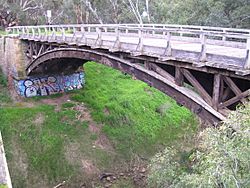Angle Vale Bridge facts for kids
Quick facts for kids Angle Vale Bridge |
|
|---|---|

Angle Vale Bridge
|
|
| Coordinates | 34°37′50″S 138°38′45″E / 34.630677°S 138.645846°E |
| Carries | Motor vehicles |
| Crosses | Gawler River |
| Locale | Heaslip Road, Angle Vale, South Australia, Australia |
| Characteristics | |
| Design | Deck arch bridge |
| Material | Sandstone timber |
| Width | 5 metres (18 ft) |
| Longest span | 26 metres (85 ft) |
| Number of spans | 1 |
| History | |
| Designer | Charles Francis Godfrey Ashwin |
| Construction end | 1876 |
| Closed | 1966 |
|
South Australian Heritage Register
|
|
| Official name: Angle Vale Bridge [Laminated Timber Arch]; Old Bridge | |
| Type: | REG - Confirmed |
| Designated: | 24 July 1980 |
| Reference #: | 13324 |
| Polygon type: | B - Building footprint |
| Subject index: | Transport (Road) - Road Bridge |
The Angle Vale Bridge is a very old and special bridge in South Australia. It was built in 1876. This bridge is unique because it's the only one of its kind left in Australia. It is a "deck arch" bridge made from strong timber and sandstone. It crosses the Gawler River on Heaslip Road in Angle Vale. The bridge is so important that it was added to the South Australian Heritage Register in 1980.
Contents
What the Bridge Looks Like
The Angle Vale Bridge has strong sandstone parts called abutments and wing walls. These support the main part of the bridge. It has four big arches made of laminated timber. Each arch spans about 26 meters (85 feet). These arches fit into special cast iron holders.
The arches hold up a timber deck, which is the flat part you drive on. This roadway is about 5.5 meters (18 feet) wide. The bridge was officially opened on November 22, 1876. A special ceremony took place with Hon. J. Colton, who was the Commissioner of Public Works. Miss Heaslip had the honor of cutting the ribbon.
The History of the Bridge
Laminated timber arch bridges started being built in Australia around 1853. These bridges were based on designs from Britain and America. However, many of them didn't last very long. This was because the timber used in Australia didn't preserve well.
The first bridges of this type in South Australia were built in 1856. They used both imported softwoods and local hardwoods. The timber pieces were glued together horizontally and bolted. But water would get between the layers, causing the wood to rot quickly. These early bridges only lasted about 12 to 16 years.
Engineers later found a better way to build them. They started gluing the timber pieces together vertically. They also added caps on top to stop water from getting in. This made the bridges much stronger and last longer.
Building the Angle Vale Bridge
Plans to build the Angle Vale Bridge began in early 1876. The design was created by Charles Francis Godfrey Ashwin. He was a supervising surveyor for the South Australia Central Road Board. The company Hack and Parker won the contract to build the bridge. J.C. Brodie was in charge of making sure the work was done correctly.
The bridge was finished very quickly, in less than nine months! It officially opened on November 22, 1876.
Charles Francis Godfrey Ashwin, the designer, was born in 1816. He started working for the Central Road Board in 1855. He became an engineer in 1861. Sadly, he passed away in 1878 while traveling back to England.
Later Years of the Bridge
In 1966, a new road was built, and the Angle Vale Bridge was no longer used for traffic. Over time, it started to fall apart. But in 1988, a big project was done to fix and restore the bridge.
In 2008, the bridge was recognized for its important engineering history. The Engineers Australia group placed a special marker there. This marker celebrates the bridge as an important part of Australia's engineering past.
Other Bridges Like It
The Angle Vale Bridge is very special because it's the only one of its kind left. Only two other early laminated timber arch bridges are known in Australia:
- The Old Currency Creek Road Bridge, built in 1873. This bridge has been changed over time with metal parts.
- The Sunnyhill Bridge, built in 1863. This bridge was later covered by water when the Millbrook Reservoir was built.

